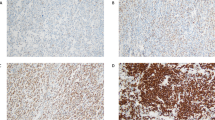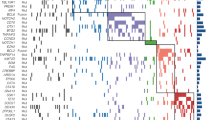Abstract
Prognostically relevant risk factors in patients with diffuse large B-cell lymphoma (DLBCL) have predominantly been evaluated in elderly populations. We tested whether previously described risk factors are also valid in younger, poor-prognosis DLBCL patients. Paraffin-embedded samples from 112 patients with de novo DLBCL, enrolled in the R-MegaCHOEP trial of the German High Grade Non-Hodgkin Lymphoma Study Group (DSHNHL) were investigated using immunohistochemistry (MYC, FOXP1, LMO2, GCET1, CD5, CD10, BCL2, BCL6, IRF4/MUM1) and fluorescence in situ hybridization (MYC, BCL2, BCL6). MYC, BCL2 and BCL6 breaks occurred in 14, 21 and 31%, respectively. In the majority of cases, MYC was simultaneously rearranged with BCL2 and/or BCL6. The adverse impact of MYC rearrangements was confirmed, but the sole presence of BCL2 breaks emerged as a novel prognostic marker associated with inferior overall survival (OS) (P=0.002). Combined overexpression of MYC and BCL2 showed only limited association with inferior OS. All immunohistochemical cell of origin classifiers applied failed to predict survival time. DLBCL tumors with significant proportion of immunoblastic and/or immunoblastic-plasmacytoid cells had inferior OS, independently from from BCL2 break. Younger, poor-prognosis DLBCL patients, therefore, display different biological risk factors compared with an elderly population, with BCL2 translocations emerging as a powerful negative prognostic marker.
This is a preview of subscription content, access via your institution
Access options
Subscribe to this journal
Receive 12 print issues and online access
$259.00 per year
only $21.58 per issue
Buy this article
- Purchase on Springer Link
- Instant access to full article PDF
Prices may be subject to local taxes which are calculated during checkout

Similar content being viewed by others
References
Swerdlow SH, Campo E, Harris NL, Jaffe ES, Pileri SA, Stein H et al (eds). WHO classification of tumours of haematopoietic and lymphoid tissues, 4th edn. International Agency for Research on Cancer: Lyon, France, 2008.
Ziepert M, Hasenclever D, Kuhnt E, Glass B, Schmitz N, Pfreundschuh M et al. Standard International prognostic index remains a valid predictor of outcome for patients with aggressive CD20+ B-cell lymphoma in the rituximab era. J Clin Oncol 2010; 28: 2373–2380.
Rosenwald A, Wright G, Chan WC, Connors JM, Campo E, Fisher RI et al. The use of molecular profiling to predict survival after chemotherapy for diffuse large-B-cell lymphoma. New Engl J Med 2002; 346: 1937–1947.
Lenz G, Wright G, Dave SS, Xiao W, Powell J, Zhao H et al. Stromal Gene Signatures in large-B-cell Lymphomas. New Engl J Med 2008; 359: 2313–2323.
Karlin L, Coiffier B . Improving survival and preventing recurrence of diffuse large B-cell lymphoma in younger patients: current strategies and future directions. Onco Targets Ther 2013; 6: 289–296.
Ott G, Ziepert M, Klapper W, Horn H, Szczepanowski M, Bernd HW et al. Immunoblastic morphology but not the immunohistochemical GCB/nonGCB classifier predicts outcome in diffuse large B-cell lymphoma in the RICOVER-60 trial of the DSHNHL. Blood 2010; 116: 4916–4925.
Coutinho R, Clear AJ, Owen A, Wilson A, Matthews J, Lee A et al. Poor concordance among nine immunohistochemistry classifiers of cell-of-origin for diffuse large B-cell lymphoma: implications for therapeutic strategies. Clin Cancer Res 2013; 19: 6686–6695.
Salles G, de Jong D, Xie W, Rosenwald A, Chhanabhai M, Gaulard P et al. Prognostic significance of immunohistochemical biomarkers in diffuse large B-cell lymphoma: a study from the Lunenburg Lymphoma Biomarker Consortium. Blood 2011; 117: 7070–7078.
Horn H, Ziepert M, Becher C, Barth TFE, Bernd HW, Feller AC et al. MYC status in concert with BCL2 and BCL6 expression predicts outcome in diffuse large B-cell lymphoma. Blood 2013; 121: 2253–2263.
Johnson NA, Slack GW, Savage KJ, Connors JM, Ben-Neriah S, Rogic S et al. Concurrent expression of MYC and BCL2 in diffuse large B-cell lymphoma treated with rituximab plus cyclophosphamide, doxorubicin, vincristine, and prednisone. J Clin Oncol 2012; 30: 3452–3459.
Green TM, Young KH, Visco C, Xu-Monette ZY, Orazi A, Go RS et al. Immunohistochemical double-hit score is a strong predictor of outcome in patients with diffuse large B-cell lymphoma treated with rituximab plus cyclophosphamide, doxorubicin, vincristine, and prednisone. J Clin Oncol 2012; 30: 3460–3467.
Tzankov A, Xu-Monette ZY, Gerhard M, Visco C, Dirnhofer S, Gisin N et al. Rearrangements of MYC gene facilitate risk stratification in diffuse large B-cell lymphoma patients treated with rituximab-CHOP. Mod Pathol 2014; 27: 958–971.
Hu S, Xu-Monette ZY, Tzankov A, Green T, Wu L, Balasubramanyam A et al. MYC/BCL2 protein co-expression contributes to the inferior survival of activated B-cell subtype of diffuse large B-cell lymphoma and demonstrates high-risk gene expression signatures: a report from The International DLBCL Rituximab-CHOP Consortium Program Study. Blood 2013; 121: 4021–4031.
Valera A, López-Guillermo A, Cardesa-Salzmann T, Climent F, González-Barca E, Mercadal S et al. MYC protein expression and genetic alterations have prognostic impact in patients with diffuse large B-cell lymphoma treated with immunochemotherapy. Haematologica 2013; 98: 1554–1562.
Schmitz N, Nickelsen M, Ziepert M, Haenel M, Borchmann P, Schmidt C et al. Conventional chemotherapy (CHOEP-14) with rituximab or high-dose chemotherapy (R-MegaCHOEP) with rituximab for young, high-risk patients with aggressive B-cell lymphoma: an open-label, randomised, phase 3 trial (DSHNHL 2002-1). Lancet Oncol 2012; 13: 1250–1259.
Lennert K, Feller A . Histopathology of Non-Hodgkin's Lymphomas. Springer Verlag: New York, USA, 1992.
Horn H, Bausinger J, Staiger AM, Sohn M, Schmelter C, Kim G et al. Numerical and structural genomic aberrations are reliably detectable in tissue microarrays of formalin-fixed paraffin-embedded tumor samples by fluorescence in situ hybridization. PLoS One 2014; 9: e95047.
Meyer PN, Fu K, Greiner TC, Smith LM, Delabie J, Gascoyne RD et al. Immunohistochemical methods for predicting cell of origin and survival in patients with diffuse large B-cell lymphoma treated with rituximab. J Clin Oncol 2011; 29: 200–207.
Fleiss JL . Measuring nominal scale agreement among many raters. Psychol Bull 1971; 76: 378–382.
Hans CP, Weisenburger DD, Greiner TC, Chan WC, Aoun P, Cochran GT et al. Confirmation of the molecular classification of diffuse large B-cell lymphoma by immunohistochemistry using a tissue microarray. Blood 2004; 103: 275–282.
Muris JJ, Ylstra B, Cillessen SA, Ossenkoppele GJ, Kluin-Nelemans JC, Eijk PP et al. Profiling of apoptosis genes allows for clinical stratification of primary nodal diffuse large B-cell lymphomas. Br J Haematol 2007; 36: 38–47.
Nyman H, Jerkeman M, Karjalainen-Lindsberg ML, Banham AH, Leppä S . Prognostic impact of activated B-cell focused classification in diffuse large B-cell lymphoma patients treated with R-CHOP. Mod Pathol 2009; 22: 1094–1101.
Choi WW, Weisenburger DD, Greiner TC, Piris MA, Banham AH, Delabie J et al. A new immunostain algorithm classifies diffuse large B-cell lymphoma into molecular subtypes with high accuracy. Clin Cancer Res 2009; 15: 5494–5502.
Barrans SL, Crouch S, Smith A, Worrillow L, Smith A, Patmore R et al. Rearrangement of MYC is associated with poor prognosis in patients with diffuse large B-cell lymphoma treated in the era of rituximab. J Clin Oncol 2010; 28: 3360–3365.
Savage KJ, Johnson NA, Ben-Neriah S, Connors JM, Sehn LH, Farinha P et al. MYC gene rearrangements are associated with a poor prognosis in diffuse large B-cell lymphoma patients Ttreated with R-CHOP chemotherapy. Blood 2009; 114: 3533–3537.
Akyurek N, Uner A, Benekli M, Barista I . Prognostic significance of MYC, BCL2, and BCL6 rearrangements in patients with diffuse large B-cell lymphoma treated with cyclophosphamide, doxorubicin, vincristine, and prednisone plus rituximab. Cancer 2011; 118: 4173–4183.
Copie-Bergman C, Gaulard P, Leroy K, Briere J, Baia M, Jais JP et al. Immuno-fluorescence in situ hybridization index predicts survival in patients with diffuse large B-cell lymphoma treated with R-CHOP: a GELA study. J Clin Oncol 2009; 27: 5573–5579.
Iqbal J, Meyer PN, Smith LM, Johnson NA, Vose JM, Greiner TC et al. BCL2 predicts survival in germinal center B-cell-like diffuse large B-cell lymphoma treated with CHOP-like therapy and rituximab. Clin Cancer Res 2011; 17: 7785–7795.
Visco C, Tzankov A, Xu-Monette ZY, Miranda RN, Tai YC, Li Y et al. Patients with diffuse large B-cell lymphoma of germinal center origin with BCL2 translocations have poor outcome, irrespective of MYC status: a report from an International DLBCL rituximab-CHOP Consortium Program Study. Haematologica 2013; 98: 255–263.
de Jong D, Koster A, Hagenbeek A, Raemaekers J, Veldhuizen D, Heisterkamp S et al. Impact of tumor microenvironment on prognosis in follicular lymphoma is dependent of specific treatment protocols. Haematologica 2009; 94: 70–77.
Pfreundschuh M, Trümper L, Osterborg A, Pettengell R, Trneny M, Imrie K et al. CHOP-like chemotherapy plus rituximab versus CHOP-like chemotherapy alone in young patients with good-prognosis diffuse large-B-cell lymphoma: a randomised controlled trial by the MabThera International Trial (MInT) Group. Lancet Oncol 2006; 7: 379–391.
Klapper W, Kreuz M, Kohler CW, Burkhardt B, Szczepanowski M, Salaverria I et al. Patient age at diagnosis is associated with the molecular characteristics of diffuse large B-cell lymphoma. Blood 2012; 119: 1882–1887.
Szczepański T, Harrison CJ, van Dongen JJ . Genetic aberrations in paediatric acute leukaemias and implications for management of patients. Lancet Oncol 2010; 11: 880–889.
Oschlies I, Salaverria I, Mahn F, Meinhardt A, Zimmermann M, Woessmann W et al. Pediatric follicular lymphoma—a clinico-pathological study of a population-based series of patients treated within the Non-Hodgkin's Lymphoma–Berlin-Frankfurt-Munster (NHL-BFM) multicenter trials. Haematologica 2010; 95: 253–259.
Masqué-Soler N, Szczepanowski M, Kohler CW, Spang R, Klapper W . Molecular classification of mature aggressive B-cell lymphoma using digital multiplexed gene expression on formalin-fixed paraffin-embedded biopsy specimens. Blood 2013; 122: 1985–1986.
Scott DW, Wright GW, Williams PM, Lih CJ, Walsh W, Jaffe ES et al. Determining cell-of-origin subtypes of diffuse large B-cell lymphoma using gene expression in formalin-fixed paraffin-embedded tissue. Blood 2014; 123: 1214–1217.
Acknowledgements
We would like to thank Beate Mann, Katja Rillich (IMISE Leipzig), Daniela Rauh (Stuttgart), Inge Klier and Theodora Nedeva (Würzburg), Olivera Batic and Charlott Botz von Drathen (Kiel), Michaela Buck (Ulm), Erika Berg (Berlin), Katharina Vogel and Ilona Schliephake (Lübeck), and Ralf Lieberz (Frankfurt) for expert technical assistance. This work was supported by the Robert-Bosch-Stiftung, Stuttgart, Germany, and by the Deutsche Krebshilfe. MZ was supported by the Deutsche Krebshilfe (grant 110884). SC was supported by the Swiss Group for Clinical Research (SAKK). WK was supported by the Deutsche Krebshilfe (grant 109547). This work was supported by the Robert-Bosch-Stiftung, Stuttgart, Germany, and by the Deutsche Krebshilfe. MZ was supported by the Deutsche Krebshilfe (grant 110884). SC was supported by the Swiss Group for Clinical Research (SAKK). WK was supported by the Deutsche Krebshilfe (grant 109547).
Author information
Authors and Affiliations
Consortia
Corresponding author
Additional information
Supplementary Information accompanies this paper on the Leukemia website
Rights and permissions
About this article
Cite this article
Horn, H., Ziepert, M., Wartenberg, M. et al. Different biological risk factors in young poor-prognosis and elderly patients with diffuse large B-cell lymphoma. Leukemia 29, 1564–1570 (2015). https://doi.org/10.1038/leu.2015.43
Received:
Revised:
Accepted:
Published:
Issue Date:
DOI: https://doi.org/10.1038/leu.2015.43
This article is cited by
-
Altered serum lipid levels are associated with prognosis of diffuse large B cell lymphoma and influenced by utility of rituximab
Annals of Hematology (2023)
-
Genetic Profiling of Diffuse Large B-Cell Lymphoma: A Comparison Between Double-Expressor Lymphoma and Non-Double-Expressor Lymphoma
Molecular Diagnosis & Therapy (2023)
-
Molecular Subgroups of Diffuse Large B Cell Lymphoma: Biology and Implications for Clinical Practice
Current Oncology Reports (2022)
-
Applying probability calibration to ensemble methods to predict 2-year mortality in patients with DLBCL
BMC Medical Informatics and Decision Making (2021)
-
Acquired resistance to DZNep-mediated apoptosis is associated with copy number gains of AHCY in a B-cell lymphoma model
BMC Cancer (2020)



